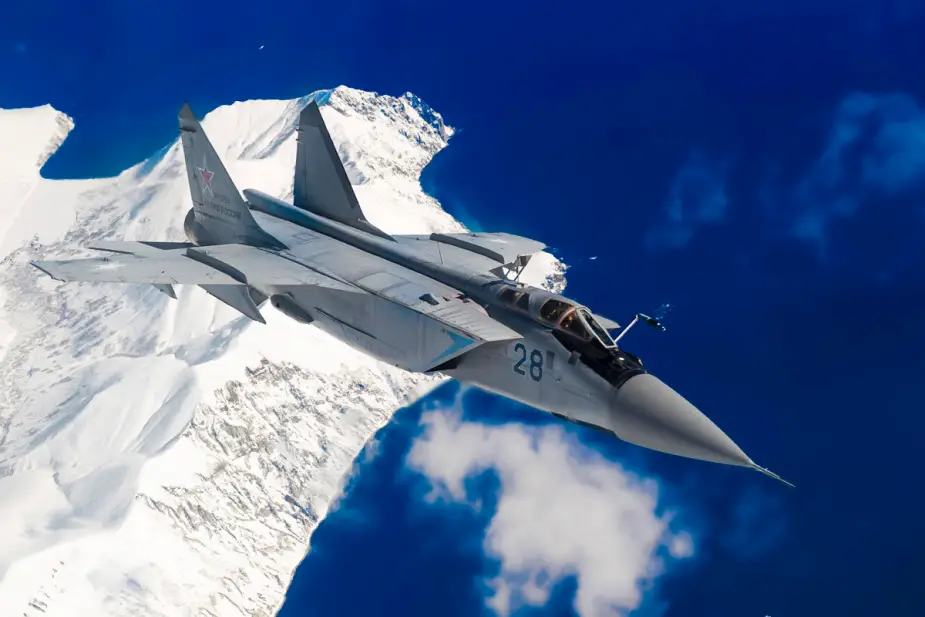Sokol Aircraft Plant in Nizhny Novgorod (NAZ) marked 90 years of existence on February 1. It is an affiliate of the MiG Corporation. The enterprise overhauls and upgrades MiG-31, MiG-29 and MiG-29UB aircraft and produces components for MiG-35, MiG-29K/KUB, and MiG-29M/M2.
Follow Air Recognition on Google News at this link
 MiG-31 Foxhound (Picture source: Rostec)
MiG-31 Foxhound (Picture source: Rostec)
Sokol was created on February 1, 1932 as the Ordzhonikidze Aircraft Plant in Gorky. It produced the aircraft designed by the Polikarpov and Lavochkin bureaus. During World War 2, it produced each fourth fighter aircraft for the front. In 1949, the enterprise began cooperating with the Mikoyan Design Bureau and producing MiG fighter jets.
The enterprise was four times decorated with government awards. It received the Orders of Lenin in 1936 and 1970, the Order of the Red Banner of Labor in 1941, and the Order of the October Revolution in 1982.
“In 2021, Sokol increased the income 1.4 times due to a complete load. Wages grew 18 percent and exceeded the average wage in Nizhny Novgorod 10 percent. Sokol has a big production program for 2022. Contracts have been signed for the overhaul and upgrade of aircraft and new deals are planned. We shall continue to operate for military-technical cooperation,” plant Director Vladimir Semenov said.
MiG-31 interceptor
Sokol produced the supersonic MiG-31 interceptor (NATO reporting name: Foxhound) in 1975-1994. It is a veteran of the Russian Aerospace Forces but has retained its unique speed and altitude characteristics. The aircraft was designed to intercept existing and prospective US air weapons. It is armed with air-to-air and air-to-surface missiles.
MiG-31 developed into a dozen of modifications, including upgraded MiG-31B with an air refueling system, MiG-BS, etc., and experimental MiG-31LL flying laboratory, as well as some export options, which did not see batch production.
The production of these interceptors stopped in 1994. In 2011, the enterprise began to upgrade the jets to the MiG-31BM level. In 2013, the first pair of upgraded interceptors went on combat duty at Monchegorsk airfield in Murmansk region. MiG-31BM carries new arms and radars that detect targets at a distance of 320 kilometers and destroy them at a distance of 280 km. The aircraft can track ten and simultaneously destroy six targets. The Russian Center of Strategy and Technology Analysis said the Aerospace Forces received in 2016 17 MiG-31BM. Over 20 aircraft were annually supplied in 2017-2018.
Modern MiG-31 is armed with the latest weapons. It carries Kinzhal complex to fire hypersonic air ballistic missiles. Deputy Prime Minister Yuri Borisov said the aircraft can accelerate the missile to the required speed at the required altitude.
The interceptor has been operating for a long time and needs an upgrade to extend the life cycle. In 2020, it was announced that work had begun to extend the resource of the aircraft glider to 3500 flight hours. NAZ told TASS the upgrade increased the combat effectiveness of MiG-31 three times and will keep the aircraft operational until the middle of the 2030s.
The interceptor has a powerful radar. Four MiG-31 can control the airspace of over one thousand kilometers wide. Merited pilot Major General Vladimir Popov said MiG-31 can control the missiles of the neighboring aircraft when it operates in the air defense system with the ground stations. “When the wing commander leads four aircraft, he can control all the weapons and long-range missiles of the four jets,” he told TASS.
The high-altitude MiG-31 interceptors will defend the Russian airspace in the north, he believes. It is due to the huge space of the Russian Extreme North and a lack of airfields there.
An upgraded MiG-31 with an electric remote control is undergoing trials. Deputy Defense Minister Alexey Krivoruchko visited NAZ on November 25, 2021, to inspect the production capacities, the overhaul and upgrade of MiG-31, and discuss the fulfillment of the arms procurement order.
Sokol plant said there is an upgrade option that switches the aircraft from mechanical to electric remote control. A line of computers has to be installed. “The option with an electric remote control is being implemented. The upgraded interceptor is undergoing trials,” the enterprise said.
© Copyright 2022 TASS. All rights reserved. This material may not be published, broadcast, rewritten or redistributed.
















